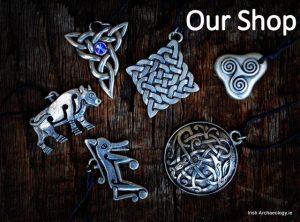County Wexford contains an unusual concentration of domestically produced medieval ceramic lamps, an artefact type which is largely absent from the rest of the country. These pieces date from the late 12th to early 14th century and are found in both urban and rural contexts.
The lamps typically have a flat, circular base, which allowed them to be safely placed on the ground or on a table, while they were carried via an upright shaft/handle. The shaft was in turn surmounted by a shallow, bowl-shaped cup that held animal fat or oil and a lighted wick (see Figures 2 & 3). They tend to be fashioned out of a reddish-orange, mica-rich clay that is reminiscent of the fabric found in the locally produced Leinster Cooking Ware pottery.
The lamps have thick bodies which precluded complete firing in simple bonfire kilns (McCutcheon & Meenan 2011, p. 97) and this left them susceptible to breakage, as can be seen in Wexford, where no complete examples have been recovered. Sometimes an attempt was made to improve the firing qualities of the lamp by inserting a long, tapering hole into the base, which often extended into the shaft. Evidence for such a void is visible in a number of Wexford lamps, including examples from Castleland, Ferns, High Hill, New Ross and Killann, Rathnure.
In shape and form the ceramic lamps closely resemble stone cresset lamps, an artefact type which dates from the mid-10th to late 12th century AD (Moore 1994, p. 433; See Figure 4 below). Stone cresset lamps are concentrated in the southeast of Ireland (ibid, p. 107) and their ceramic counterparts appear to have an even more focused distribution, with the majority coming from county Wexford (see Figure 5).
The ceramic lamps from Wexford include an example from the medieval fosse surrounding Ferns’ castle (Sweetman et al 1979, pp 231-2), fragments from rural medieval settlement sites at Landscape, New Ross (McCutcheon 2012), Castleland, Ferns (Moriarty, 2020) and Killann, Rathnure (Moriarty, 2021), as well as from medieval moated sites at Carrowreagh, Taghmon (Doyle 2009, pp. 52-53), Coolamurry, Davidstown (McCutcheon 2009, p. 16) and Barmoney, Bree (National Museum of Ireland (1978:133)2A-C)131).
Fragments are also known from urban contexts, such as Cornmarket in Wexford town (McCutcheon 2009, p.16) and High Hill, New Ross (Moriarty 2021), while slightly further afield, two lamps were also recovered during excavations in Waterford (Moore 1997, pp. 432-6). There is also a small assemblage of ceramic lamps from Dublin and Cork cities (McCutcheon 2006), but these are mainly French imports rather than locally produced objects
In England, ceramic cresset lamps typically date from the 11th to 12th centuries (Moore 1984, p. 108) and they appear to have been gradually replaced by candles during the 13th century, with the latter predominating by about 1300 AD (Egan 2012, p. 126).
In an Irish context, the use of pottery lamps probably coincides with the arrival of the Anglo-Normans in the late 12th century, as the country was largely aceramic until then. Their apparent restricted geographical range in Ireland, in an area associated with the initial Anglo-Norman colonisation, may also indicate that, like in England, the ceramic lamps had a relatively short usage span, being largely replaced by candles during the 14th century.
Bibliography
Doyle N. 2009 ‘Medieval and Post-Medieval pottery from Carrowreagh’ in Tierney, J. Archaeological Excavation Report E0471 Carrowreagh, Co. Wexford, Medieval Moated Site and pottery kiln, pp 49-71, via Eachtra Journal, Issue 4 https://www.slideshare.net/eachtra/archaeological-excavation-report-e0471-carrowreagh-co-wexford-ireland-eap-journal. Accessed 5-3-21
Egan, G. 2012 The Medieval Household. Daily Living c. 1150-1450. The Boydell Press, Woodbridge
McCutcheon, C. 2006 Medieval Pottery from Wood Quay, Dublin. The 1974-6 Waterfront Excavations, Royal Irish Academy, Dublin
McCutcheon, C. 2009 ‘The Medieval pottery’ in Fegan, G. ‘Final Report, Licence 04E0326, Site 4 Coolamurry townland, Co. Wexford’, Unpublished report, Valarie J. Keeley Ltd, pp. 14-16
McCutcheon C. & Meenan R. 2011 ‘Pots and Hearth: domestic pottery in Historic Ireland’ in Proceedings of the Royal Irish Academy: Archaeology, Culture, History, literature, Vol. 111C, Special Issue, Domestic Life in Ireland, pp. 91-113
McCutcheon, C. 2012 ‘The post-medieval and medieval pottery (Appendix 10.2)’ in Hession, J. Final Excavation Report for Landscape 2 in the townland of Landscape, Co. Wexford, Volume 3 (Appendices 7-15 Specialist Reports). Unpublished Report for Rubicon Archaeology
Moore, Michael, J. 1984 ‘Irish Cresset-Stones’ in The Journal of the Royal Society of Antiquaries of Ireland, Vol. 114, pp. 98-116
Moore, Michael, J. 1997 ‘The Stone and Pottery Lamps’ in Hurley M.F et al (eds) Late Viking Age and Medieval Waterford Excavations 1986-1992, pp. 432-436, Waterford Corporation, Waterford
Moriarty, C. 2020 The Ceramic Lamp Report for Castlelands, Ferns, Unpublished Report for Stafford McLoughlin Archaeology
Moriarty, C. 2021 The Ceramic Lamp Report for High Hill, New Ross, Unpublished Report for Stafford McLoughlin Archaeology
Moriarty, C. 2021 The Ceramic Lamp Report for Killann, Co. Wexford, Unpublished Report for De Faoite Archaeology
Sweetman, D. P., Mitchell, G. F. & Whelan, B. 1979 ‘Archaeological Excavations at Ferns Castle, Co. Wexford’ in Proceedings of the Royal Irish Academy: Archaeology, Culture, History, Literature Vol. 79, pp. 217-245








